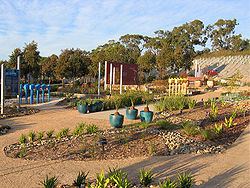This is an old revision of this page, as edited by Aaron Schulz (talk | contribs) at 06:21, 7 September 2006 (Unprotected Cranbourne, Victoria: Page protected for a while; hopefully protection is no longer necessary.). The present address (URL) is a permanent link to this revision, which may differ significantly from the current revision.
Revision as of 06:21, 7 September 2006 by Aaron Schulz (talk | contribs) (Unprotected Cranbourne, Victoria: Page protected for a while; hopefully protection is no longer necessary.)(diff) ← Previous revision | Latest revision (diff) | Newer revision → (diff)

Cranbourne is a suburb of Melbourne, Victoria, Australia approximately 49 kilometres south-east of the CBD (via the M1 and the South Gippsland Highway) and is situated at an elevation of 50 metres above sea-level. Its Local Government Area is the City of Casey.
The Cranbourne area consists of the following suburbs/districts: Cranbourne, Cranbourne North, Cranbourne East, Cranbourne South, Cranbourne West, The Hunt Club, Junction Village, Brookland Greens, and Central Park.
History
Cranbourne was formally a town in its own right and was the site of the old Shire of Cranbourne offices, (the building is still existent on the corner of South Gippsland Highway and Sladen Street).
Prior to European settlement the area is thought to have been occupied by the Boonwurrung Aborigines. The first white settlers, the Ruffy brothers, arrived in 1836. They later opened the Cranbourne Inn.
The area was greatly opened up by settlers from the 1860s. Progress in developing the land around Cranbourne was hampered by the Koo Wee Rup swampland. However William Lyall (who bought land in the swamp area) assisted in coordinating the draining of the swamp to make it useable as farmland.
In 1860 a number of meteorites landed in the area. The largest, at 1.5 tonnes, was then considered the world's largest.
Cranbourne was proclaimed a town in 1861 and the Shire of Cranbourne was proclaimed in 1868. In 1994 the Shire was proclaimed a City but later in the same year most of the City was amalgamated with the City of Berwick to form the City of Casey.

The population of Cranbourne was 1,800 in 1976, rising to 14,005 in 1986 and 18,886 in 1991. Cranbourne currently has an estimated population of at least 39,000.
Places
In the south of Cranbourne is the Royal Botanic Gardens, Cranbourne, and the Cranbourne Racecourse & Recreation Reserve. Cranbourne also contains the Cranbourne Golf Club, the Amstel Golf Club, the Ranfurlie Golf Club, a swimming pool, The Shed (an indoor skating facility), a Sports Centre (basketball, netball, and indoor soccer), Casey Indoor Sports Centre, a public library, and Bowland (a ten-pin bowling complex).
Schools
Schools in the Cranbourne area include St. Peters Catholic Co-Ed College, St. Agathas Catholic School, St. Theresa's Catholic Primary School, Cranbourne Secondary College, Lyndhurst Secondary College, Cranbourne Christian College, Cranbourne Primary School, Cranbourne South Primary School, Cranbourne West Primary School, Rangebank Primary School, Courtenay Gardens Primary School, and Cranbourne Specialist School. Chisholm Institute of TAFE also has a campus in Cranbourne, to the city's east. To cater for the growth in Cranbourne several primary schools have been proposed.
Shopping centres
Shopping centres in the Cranbourne area include the Thompson Parkway Shopping Centre, the Great Southern Home Centre, and Cranbourne Centro Shopping Centre.
Sports clubs
Sporting Clubs in the Cranbourne area include the Cranbourne South West Netball Association, the golf club, and there are leagues in Bowland.
Events
The MRA Cranbourne GP Run is held each year on the Saturday of the Australian Motorcycle Grand Prix.
Cranbourne races are an established event on the racing calendar. Greyhound and harness racing are also held.
Public transport
The terminus of the Cranbourne railway line is at Cranbourne railway station.
External links
This article about a place in Melbourne is a stub. You can help Misplaced Pages by expanding it. |